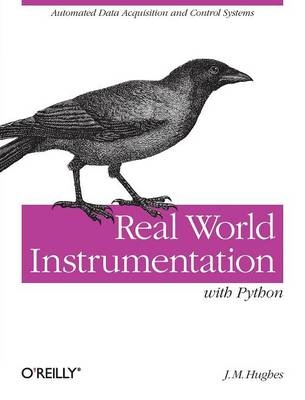
Real World Instrumentation with Python
O'Reilly (Verlag)
978-0-596-80956-0 (ISBN)
Learn how to develop your own applications to monitor or control instrumentation hardware. Whether you need to acquire data from a device or automate its functions, this practical book shows you how to use Python's rapid development capabilities to build interfaces that include everything from software to wiring. You get step-by-step instructions, clear examples, and hands-on tips for interfacing a PC to a variety of devices.
Use the book's hardware survey to identify the interface type for your particular device, and then follow detailed examples to develop an interface with Python and C. Organized by interface type, data processing activities, and user interface implementations, this book is for anyone who works with instrumentation, robotics, data acquisition, or process control.
- Understand how to define the scope of an application and determine the algorithms necessary, and why it's important
- Learn how to use industry-standard interfaces such as RS-232, RS-485, and GPIB
- Create low-level extension modules in C to interface Python with a variety of hardware and test instruments
- Explore the console, curses, TkInter, and wxPython for graphical and text-based user interfaces
- Use open source software tools and libraries to reduce costs and avoid implementing functionality from scratch
J. M. Hughes (John M. Hughes) is an embedded systems engineer with over 30 years ofexperience in electronics, embedded systems and software, aerospace systems, and scientific applications programming. He was responsible for the surface imaging software on the Phoenix Mars Lander, and has worked on digital engine control systems for commercial and military aircraft, automated test systems, radio telescope data acquisition, and real-time adaptive optics controls for astronomy. Hughes has been using Python for many years in a variety of applications. He is currently working on the software for a multi-wavelength laser interferometer system for verifying the alignment of telescope mirror segments, written mostly in Python.
Preface
Chapter 1: Introduction to Instrumentation
Chapter 2: Essential Electronics
Chapter 3: The Python Programming Language
Chapter 4: The C Programming Language
Chapter 5: Python Extensions
Chapter 6: Hardware: Tools and Supplies
Chapter 7: Physical Interfaces
Chapter 8: Getting Started
Chapter 9: Control System Concepts
Chapter 10: Building and Using Simulators
Chapter 11: Instrumentation Data I/O
Chapter 12: Reading and Writing Data Files
Chapter 13: User Interfaces
Chapter 14: Real World Examples
Appendix A: Free and Open Source Software Resources
Appendix B: Instrument Sources
Index
| Erscheint lt. Verlag | 28.12.2010 |
|---|---|
| Verlagsort | Sebastopol, USA |
| Sprache | englisch |
| Maße | 178 x 233 mm |
| Gewicht | 807 g |
| Themenwelt | Informatik ► Programmiersprachen / -werkzeuge ► Python |
| Mathematik / Informatik ► Informatik ► Web / Internet | |
| ISBN-10 | 0-596-80956-5 / 0596809565 |
| ISBN-13 | 978-0-596-80956-0 / 9780596809560 |
| Zustand | Neuware |
| Informationen gemäß Produktsicherheitsverordnung (GPSR) | |
| Haben Sie eine Frage zum Produkt? |
aus dem Bereich


